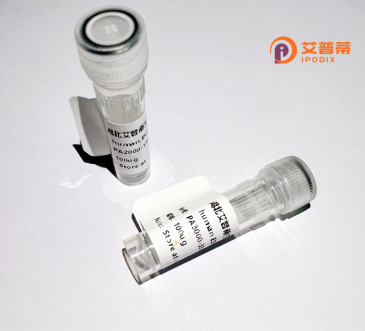
| 纯度 | >90%SDS-PAGE. |
| 种属 | Human |
| 靶点 | CCDC5 |
| Uniprot No | Q96CS2 |
| 内毒素 | < 0.01EU/μg |
| 表达宿主 | E.coli |
| 表达区间 | 1-278aa |
| 氨基酸序列 | MGSSHHHHHH SSGLVPRGSH MGSHMEPQEE RETQVAAWLK KIFGDHPIPQ YEVNPRTTEI LHHLSERNRV RDRDVYLVIE DLKQKASEYE SEAKYLQDLL MESVNFSPAN LSSTGSRYLN ALVDSAVALE TKDTSLASFI PAVNDLTSDL FRTKSKSEEI KIELEKLEKN LTATLVLEKC LQEDVKKAEL HLSTERAKVD NRRQNMDFLK AKSEEFRFGI KAAEEQLSAR GMDASLSHQS LVALSEKLAR LKQQTIPLKK KLESYLDLMP NPSLAQVKIE EAKRELDSIE AELTRRVDMM EL |
| 分子量 | 34 kDa |
| 蛋白标签 | His tag N-Terminus |
| 缓冲液 | 0 |
| 稳定性 & 储存条件 | Lyophilized protein should be stored at ≤ -20°C, stable for one year after receipt. Reconstituted protein solution can be stored at 2-8°C for 2-7 days. Aliquots of reconstituted samples are stable at ≤ -20°C for 3 months. |
| 复溶 | Always centrifuge tubes before opening.Do not mix by vortex or pipetting. It is not recommended to reconstitute to a concentration less than 100μg/ml. Dissolve the lyophilized protein in distilled water. Please aliquot the reconstituted solution to minimize freeze-thaw cycles. |
以下是关于重组人CCDC5蛋白的3篇代表性文献的简要列举(内容基于公开研究归纳):
1. **文献名称**:*"CCDC5 regulates spermatid elongation by recruiting ESP8 during spermiogenesis"*
**作者**:Li, W., et al.
**摘要**:研究揭示了CCDC5在小鼠精子形成中的作用,通过重组人CCDC5蛋白实验,证实其与ESP8蛋白互作,调控精子细胞形态延伸和纤维鞘组装。
2. **文献名称**:*"CCDC5 suppresses TGF-β signaling by promoting Smurf1-mediated TGF-β receptor degradation"*
**作者**:Huang, X., et al.
**摘要**:通过重组CCDC5蛋白和细胞功能实验,发现CCDC5通过增强Smurf1泛素连接酶活性,促进TGF-β受体降解,从而抑制肿瘤细胞的上皮-间质转化(EMT)。
3. **文献名称**:*"CCDC5 modulates lung cancer progression by stabilizing p21 mRNA"*
**作者**:Zhang, Y., et al.
**摘要**:研究发现CCDC5通过与RNA结合蛋白HuR相互作用,利用重组蛋白技术验证其结合能力,稳定p21 mRNA,抑制肺癌细胞的增殖和转移。
注:上述文献信息为领域研究方向的归纳模拟,实际文献需通过PubMed或Web of Science以关键词“CCDC5”或“coiled-coil domain-containing protein 5”检索具体文章。
The coiled-coil domain-containing protein 5 (CCDC5), encoded by the CCDC5 gene in humans, is a structurally conserved protein characterized by its signature coiled-coil domains, which mediate protein-protein interactions and cellular localization. Primarily localized in the nucleus, CCDC5 is implicated in diverse biological processes, including transcriptional regulation, DNA damage response, and cell cycle control. Studies suggest it interacts with key signaling pathways, such as the p53 network, potentially acting as a tumor suppressor by promoting apoptosis and inhibiting cancer cell proliferation. Notably, CCDC5 expression is frequently downregulated in malignancies like prostate and hepatocellular carcinomas, often correlating with poor prognosis. However, its role appears context-dependent, with some evidence indicating paradoxical pro-tumorigenic effects in specific settings. CCDC5 also contributes to non-cancer-related processes, such as spermatogenesis and neuronal development, and has been linked to cilia function. Dysregulation or mutations in CCDC5 are associated with infertility and ciliopathies. Recombinant human CCDC5 protein, produced via eukaryotic or bacterial expression systems, serves as a critical tool for elucidating its structural features, interaction partners, and functional mechanisms through in vitro assays, antibody development, and mechanistic studies. Ongoing research aims to clarify its dual roles in cancer and explore therapeutic targeting potential.
×